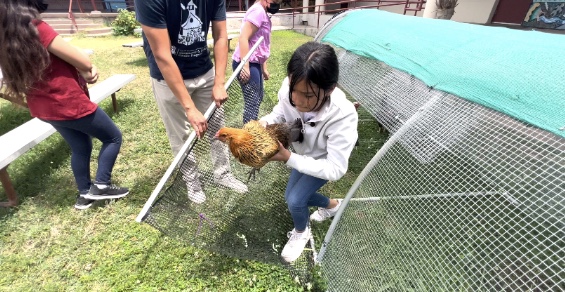How school gardening programs spark curiosity and develop lifelong learners
By Lyndsey Waugh
Wonderment. It’s perhaps one of the best things about childhood and what makes spending time with young children so enjoyable. To see the world again through their eyes… The spark of curiosity as clouds form across the sky, a sense of awe while quietly watching a spider slowly build a web, or wondering why some flowers close with the setting of the sun.
 The joy of wonderment is a fundamental part of early childhood experiences, yet as we age, there is a shift. Curiosity is replaced with answers, structure, and schedules, and slowly wonderment becomes less and less noticeable, as responsibility and the pressures of growing up take hold.
The joy of wonderment is a fundamental part of early childhood experiences, yet as we age, there is a shift. Curiosity is replaced with answers, structure, and schedules, and slowly wonderment becomes less and less noticeable, as responsibility and the pressures of growing up take hold.
School gardening programs embrace and encourage a child’s innate curiosity, melding wonderment with academics as children learn through hands-on lessons taught in the outdoor classroom.
“We often jump to the benefits that school gardening programs have on student academic outcomes because of their effectiveness in teaching science, math and other subject matters, but first and foremost, school gardening experiences help students keep a sense of wonderment alive as they begin to understand the world around them,” explains Em Shipman, executive director of KidsGardening.
 This materializes as a lifelong love of learning. “We all know older people who still have that spark. They’re curious. They’re the 80-year-olds going out for a walk, slowing down to notice the leaves unfurling on trees as they pass by in spring, or who are hungrily reading new books and learning new things,” says Shipman.
This materializes as a lifelong love of learning. “We all know older people who still have that spark. They’re curious. They’re the 80-year-olds going out for a walk, slowing down to notice the leaves unfurling on trees as they pass by in spring, or who are hungrily reading new books and learning new things,” says Shipman.
But it’s more than that, she explains. Lifelong learners may also be able to navigate interpersonal relationships better, be more self-reflective, and maintain a healthier mindset because of their ability to adjust their perspective as greater insights or learnings unfold.
“Helping kids develop a lifelong love of learning will not only bring joy to their living experiences, but it also gives them a framework and motivation to seek out new answers and find the discovery process rewarding,” says Shipman. “This is core to building healthy relationships and perhaps even being willing to change career paths or be more accepting of different perspectives.”
Moses Thompson, director of University of Arizona’s School Garden Workshop, couldn’t agree more. Through a unique partnership with Tucson Unified School District, Thompson and his team support 70 school gardens, more than 30,000 students annually.
“Our school garden spaces are living classrooms where students are highly motivated to learn because the ability to connect with nature, observe plant life cycles, and grow their own fruits and vegetables feeds their curiosity in a way that engages all their senses,” says Thompson. “This heightens their learning experience and retention, which is great for all learners, especially those who sometimes struggle in a typical classroom setting.”
Manzo Elementary School is recognized nationally and internationally for its outstanding school garden programming, which is core to the school’s culture. Classrooms open into a central outdoor greenspace that serves as the anchor point to the garden program. There, a mix of raised and lowered garden beds filled with fresh vegetables are spread amongst a greenhouse where students oversee plant germination; a chicken coop where birds are rotated out to the grass area throughout the day to graze; and a fully operational aquaponics system, where plants and fish grow together in harmony. It’s a magical space, brimming with wonderment for students, parents, and teachers alike.
Thompson explains that the garden also provides students with the quiet space for self-reflection or for a school counselor to work with a student in an environment that is more inviting and disarming than an administrative office.
 “When we bring a student who may be struggling with an issue at home or an issue in the classroom into the garden to talk about how they’re feeling, it’s a whole different ball game,” he said. “They’re able to release tensions they’re holding by moving their body and use skills like observation to connect first with the world around them and their body, and then to the root of what’s causing their feelings so they can learn how to work through them.”
“When we bring a student who may be struggling with an issue at home or an issue in the classroom into the garden to talk about how they’re feeling, it’s a whole different ball game,” he said. “They’re able to release tensions they’re holding by moving their body and use skills like observation to connect first with the world around them and their body, and then to the root of what’s causing their feelings so they can learn how to work through them.”
Across the country, thousands of school gardens provide outdoor experiential learning for students. Still, access to garden education is still out of reach for most schools. Arizona’s hometown grocer, Sprouts Farmers Market, wants to change that. Sprouts has been actively involved in the school garden movement since 2015, and the company views these outdoor learning spaces as a game changer in helping kids grow healthy. Through its Sprouts Healthy Communities Foundation, Sprouts is investing more than $3 million this year into school gardening programs nationwide that will provide three million students with access to outdoor learning. During Earth Month, Sprouts is partnering with Kids Gardening to host a “school garden giveaway” where schools can be nominated to receive a new or refreshed learning garden, plus a modest grant budget to assist with teacher training and programming.
For Shipman, the idea of “every student in every school having a garden” is big and very exciting.
She wonders aloud, “What would a world look like if every student in every school had access to a garden, where all students grew up to become lifelong learners full of wonderment? What kind of world would that be?”
Kids Garden Logo
Visit KidsGardening.org to learn more about their work to support youth gardening.
Sprouts Foundation Logo

Celebrate Earth Day with the Sprouts Healthy Communities Foundation at Green Living’s Science Center Event on Saturday, April 21. Sprouts will be on site to share more about their school gardening programs, plus a few hands-on activities to spark kids’ curiosity around eating fresh fruits and veggies!
Take a Walk in “Wonderment”
Expand your sense of awe for the world around you. Take yourself on a Wonder Walk to begin connecting with the experience of wonderment in your life. Or consider taking a Wonder Walk with a child to share in their curiosity. Turn cell phones off for an even better experience!
- Set off without a destination in mind. If you need parameters, give yourself a time limit. This wander is about the journey, not the destination.
- Get out of your head and notice the world around you. What catches your eye? What do you notice about it? What do you wonder?
- Try on different lenses to study the world around you. Look at the micro-scale. What’s growing between the cracks in the sidewalk? Then zoom out to the macro. Why is the land around you shaped as it is?
- What do you see that brings you a sense of calm, wonder, or joy? Allow this feeling to sit with you as you continue throughout your day. Consider journaling or writing “one word” to capture the feeling of your experience.






